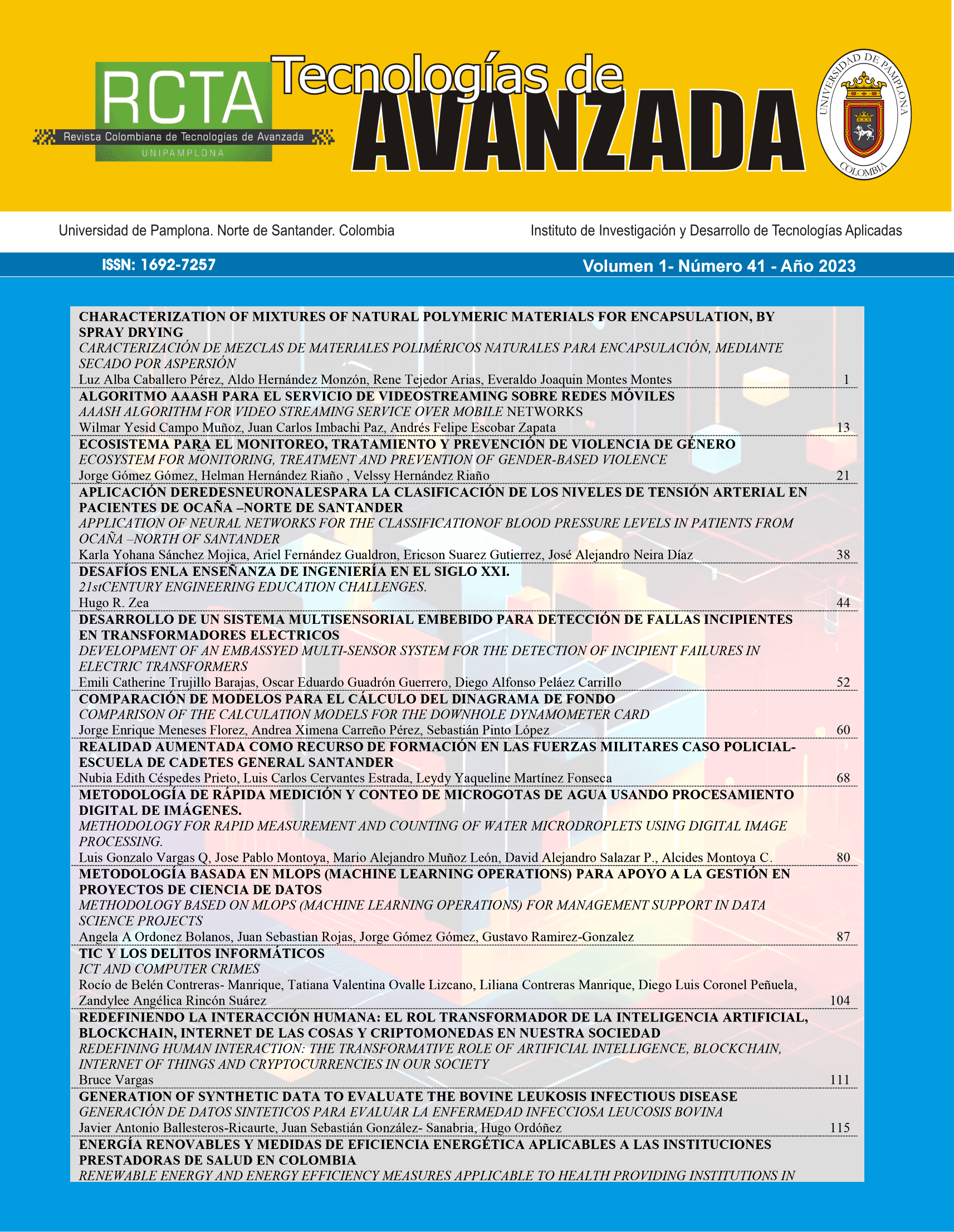ALGORITMO AAASH PARA EL SERVICIO DE VIDEOSTREAMING SOBRE REDES MÓVILES
DOI:
https://doi.org/10.24054/rcta.v1i41.2413Palabras clave:
AAASH, QoS, red móvil, videostreamingResumen
Los servicios soportados por la tecnología de videostreaming son los que más tráfico generan sobre las redes móviles. Una de las formas de hacer frente a esta situación, es mediante el uso de protocolos adaptativos, que permiten adecuar el tráfico del servicio a las condiciones de la red para mantener las condiciones de calidad. Por lo que surge el protocolo de transmisión adaptable y dinámica sobre HTTP (DASH - Dynamic Adaptive Streaming over HTTP). En este artículo se aplica el algoritmo adaptativo para streaming HTTP AAASH (Adaptation Algorithm for Adaptive Streaming over HTTP) en los clientes de una red móvil celular. Se presentan las condiciones del escenario de experimentación y el algoritmo se ejecuta en diferentes escenarios incrementando la cantidad de usuarios que consumen video mediante DASH de manera simultánea. AAASH muestra ser adecuado, puesto que se obtienen parámetros de calidad de servicio los cuales satisfacen los requerimientos.
Descargas
Citas
-1:2012, I. (2012). ISO - ISO/IEC 23009-1:2012 - Information technology — Dynamic adaptive streaming over HTTP (DASH) — Part 1: Media presentation description and segment formats. Retrieved August 3, 2022, from https://www.iso.org/standard/57623.html
Agusti, R., Bernardo, F., Casadevall, F., Ferrús, R., Pérez-Romero, J., & Sallent, O. (2010). LTE: NUEVAS TENDENCIAS EN COMUNICACIONES MÓVILES AUTORES.
Atehortua, J., Yesid Campo, W., & Elías Chanchí, G. (2022). Proposal of a tool for the automatic estimation of quality of experience in MPEG-DASH scenarios. Przeglad Elektrotechniczny. https://doi.org/10.15199/48.2022.08.26
Campo-Muñoz, W. Y., Andrés, Escobar-Zapata, F., Juan, & Imbachi-Paz, C. (2019). Análisis del servicio de video streaming basado en el algoritmo FDASH sobre LTE. Ciencia e Ingeniería Neogranadina, 29(1), 67–80. https://doi.org/10.18359/RCIN.3122
Cisco. (2017). Video Quality of Service (QOS) Tutorial - Cisco. Retrieved April 1, 2023, from https://www.cisco.com/c/en/us/support/docs/quality-of-service-qos/qos-video/212134-Video-Quality-of-Service-QOS-Tutorial.html
Colonnese, S., Conti, F., Scarano, G., Rubin, I., & Cuomo, F. (2022). Premium quality or guaranteed fluidity? Client-transparent DASH-aware bandwidth allocation at the radio access network. Journal of Communications and Networks, 24(1), 59–67. https://doi.org/10.23919/JCN.2021.000046
Concolato, C., Le Feuvre, J., Denoual, F., Mazé, F., Nassor, E., Ouedraogo, N., & Taquet, J. (2018). Adaptive Streaming of HEVC Tiled Videos Using MPEG-DASH. IEEE Transactions on Circuits and Systems for Video Technology, 28(8), 1981–1992. https://doi.org/10.1109/TCSVT.2017.2688491
Ericsson. (2022). Past and present reports - Mobility Report - Ericsson. Retrieved April 1, 2023, from https://www.ericsson.com/en/reports-and-papers/mobility-report/reports
Gadaleta, M., Chiariotti, F., Rossi, M., & Zanella, A. (2017). D-DASH: A Deep Q-Learning Framework for DASH Video Streaming. IEEE Transactions on Cognitive Communications and Networking, 3(4), 703–718. https://doi.org/10.1109/TCCN.2017.2755007
Handbook, C. Q. (2020). Cisco QoS Handbook 2nd Edition.
Malinverno, M., Mangues-Bafalluy, J., Casetti, C. E., Chiasserini, C. F., Requena-Esteso, M., & Baranda, J. (2020). An edge-based framework for enhanced road safety of connected cars. IEEE Access, 8, 58018–58031. https://doi.org/10.1109/ACCESS.2020.2980902
Miller, K., Quacchio, E., Gennari, G., & Wolisz, A. (2012). Adaptation algorithm for adaptive streaming over HTTP. 2012 19th International Packet Video Workshop, PV 2012, 173–178. https://doi.org/10.1109/PV.2012.6229732
NS-3 Project. (2023). ns-3: src/lte/examples/lena-simple-epc.cc Source File. Retrieved April 1, 2023, from https://www.nsnam.org/docs/release/3.19/doxygen/lena-simple-epc_8cc_source.html
Orozco, H. F. B., Muñoz, W. Y. C., & Hoyos, E. A. (2021). Revista Ingeniería. Ingeniería, 26(3), 381–400. https://doi.org/10.14483/23448393.17960
Sabbah, A., Jarwan, A., Issa, O., & Ibnkahla, M. (2018). Enabling LTE emulation by integrating CORE emulator and LTE-EPC Network (LENA) Simulator. IEEE International Symposium on Personal, Indoor and Mobile Radio Communications, PIMRC, 2017-October, 1–6. https://doi.org/10.1109/PIMRC.2017.8292642
Solano-Hurtado, L. R., & Soto-Cordova, M. M. (2021). A Study on Video Streaming Quality of DASH Scheme in Multimedia Services. 2021 7th Congreso Internacional de Innovacion y Tendencias En Ingenieria, CONIITI 2021 - Conference Proceedings. https://doi.org/10.1109/CONIITI53815.2021.9619720
Tian, G., & Liu, Y. (2016). Towards Agile and Smooth Video Adaptation in HTTP Adaptive Streaming. IEEE/ACM Transactions on Networking, 24(4), 2386–2399. https://doi.org/10.1109/TNET.2015.2464700
Van Der Hooft, J., Petrangeli, S., Wauters, T., Huysegems, R., Alface, P. R., Bostoen, T., & De Turck, F. (2016). HTTP/2-Based Adaptive Streaming of HEVC Video over 4G/LTE Networks. IEEE Communications Letters, 20(11), 2177–2180. https://doi.org/10.1109/LCOMM.2016.2601087
Vergados, D. J., Michalas, A., Sgora, A., & Vergados, D. D. (2014). A fuzzy controller for rate adaptation in MPEG-DASH clients. IEEE International Symposium on Personal, Indoor and Mobile Radio Communications, PIMRC, 2014-June, 2008–2012. https://doi.org/10.1109/PIMRC.2014.7136501
Descargas
Publicado
Versiones
Cómo citar
Número
Sección
Licencia
Derechos de autor 2023 REVISTA COLOMBIANA DE TECNOLOGIAS DE AVANZADA (RCTA)

Esta obra está bajo una licencia internacional Creative Commons Atribución-NoComercial 4.0.














